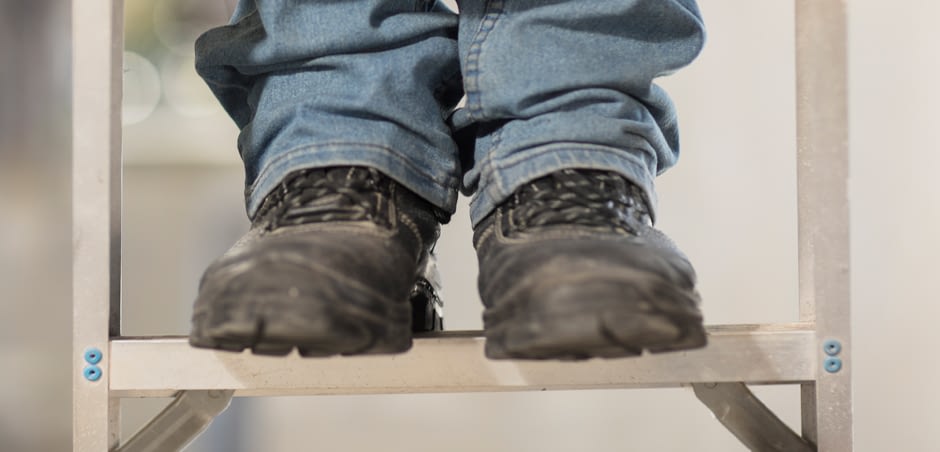
When it comes to home maintenance, not every task happens at eye level. So whether you’re changing a light bulb or cleaning your gutters, a ladder is often needed to bring your project within reach.
You may not think of these jobs as particularly dangerous, but there’s risk involved any time you leave the ground – even if it’s only a few feet. In fact, according to the CDC, falls from portable ladders are among the leading causes of work-related injuries.
To help avoid a fall during your next project, follow these tips on how to choose the right ladder and climb it with confidence.
How to Choose The Right Ladder
Depending on the task at hand, some ladder configurations are safer than others. Most new ladders are designed for flexibility. But they can still come up short if they’re not the right tool for the job.
Here are some features to consider before making your ladder selection:
- Size: A ladder isn’t much help if you still can’t reach what you need, so be sure to choose an adjustable or fixed ladder that reaches your desired height safely. The ladder should be high enough that you don’t need to stand on the top rung or step. Just be aware that the larger the ladder, the more difficult it may be to move.
- Materials: Ladders are commonly made of fiberglass, wood, or metal. Aluminum ladders are generally the lightest and strongest, but they shouldn’t be used near electrical hazards. Always select a material that’s safe to use in your environment. That means using fiberglass or wooden ladders when the job involves power lines or electrical equipment.
- Duty Rating: This rating represents the maximum weight a ladder can carry based on its design and materials.
Before using a ladder, add up your body weight and the weight of anything you’ll carry with you, including tools, clothing, and gear. Then, choose a ladder with the appropriate duty rating and don’t exceed it. - Configuration: Different ladder types serve different purposes. For instance, extension ladders are great for accessing rooftops, while A-frame ladders are helpful for jobs inside the house. If you’re looking for versatility, choose a combination or articulated ladder. These ladders feature adjustable configurations and multiple locking hinges, allowing them to reach higher and fit into more spaces.
How to Use a Ladder Safely
Choosing the right ladder is an important first step. But using it correctly should never be overlooked. Keep these rules in mind before you step onto the first rung:
- Read the labels. Each ladder comes with warnings and safety labels specific to its design. Read all labels and markings before setting up and check for any special instructions or features.
- Keep areas clear. Avoid placing ladders in doorways where they can be knocked over. You can block or guard the door if there’s no other option, but be sure to keep areas clear for those getting on and off the ladder.
- Lock it down. For any portable or extension ladder, applying weight to an unlocked joint could cause it to collapse. Even if the base feels sturdy, ensure all joints are locked before climbing.
- Inspect your ladder. Make sure your ladder is in good working condition before you use it. If you find bent and broken pieces, mark the ladder as unusable and dispose of or repair it.
- Wear proper attire. Clothing and gear should help keep your hands free and your feet secure. Wear clean, slip-resistant shoes for increased traction and a tool belt to avoid carrying loose items up with you.
- Mind the base. Always keep the ladder’s legs on a stable surface. Never place it on a box, barrel, or other base for additional height. For straight or extension ladders, move the base further from the wall as the ladder’s working length increases.
- Don’t lean. When climbing, face the ladder and securely grip the rungs. If a work surface is out of reach, avoid the temptation to lean or overreach. Instead, climb down and move the ladder to a better position.
- Use three points of contact. If there were a “Golden Rule” of ladder safety, this is it: Maintain three points of contact with the ladder at all times. That means two hands and a foot– or two feet and a hand– should always be touching the ladder until you’re back on the ground. Following this tip will help prevent you from losing your balance or tipping the ladder.
Stay on Top of Your Investment
You work hard to take care of your home. From needed repairs to cosmetic upgrades, it’s an investment that requires constant attention.
With the right homeowners’ insurance, you can rest easy knowing that while you’re looking out for it, we’re looking out for you. Because when it comes to protecting your home, we’re here for you from the first question to the final follow-up.
Contact your local insurance agent today to review your coverage or get a quote.
ERIE® insurance products and services are provided by one or more of the following insurers: Erie Insurance Exchange, Erie Insurance Company, Erie Insurance Property & Casualty Company, Flagship City Insurance Company and Erie Family Life Insurance Company (home offices: Erie, Pennsylvania) or Erie Insurance Company of New York (home office: Rochester, New York). The companies within the Erie Insurance Group are not licensed to operate in all states. Refer to the company licensure and states of operation information.
The insurance products and rates, if applicable, described in this blog are in effect as of January 2024 and may be changed at any time.
Insurance products are subject to terms, conditions and exclusions not described in this blog. The policy contains the specific details of the coverages, terms, conditions and exclusions.
The insurance products and services described in this blog are not offered in all states. ERIE life insurance and annuity products are not available in New York. ERIE Medicare supplement products are not available in the District of Columbia or New York. ERIE long term care products are not available in the District of Columbia and New York.
Eligibility will be determined at the time of application based upon applicable underwriting guidelines and rules in effect at that time.
Your ERIE agent can offer you practical guidance and answer questions you may have before you buy.

A better insurance experience starts with ERIE.
Haven’t heard of us? Erie Insurance started with humble beginnings in 1925 with a mission to emphasize customer service above all else. Though we’ve grown to reach the Fortune 500 list, we still haven’t lost the human touch.
Contact IIS, LLC. – Indiana Insurance Solutions today to experience the ERIE difference for yourself.
